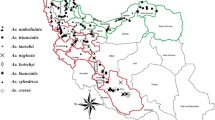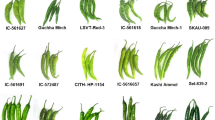Abstract
The genetic diversity and relationship among South and East Asian melon Cucumis melo L. were studied by using RAPD analysis of 69 accessions of melon from India, Myanmar, China, Korea, and Japan. The genetic diversity was large in India, and quite small in Group Conomon var. makuwa and var. conomon from East Asia, clearly indicating a decrease in genetic variation from India toward the east. Cluster analysis based on genetic distance classified 17 groups of accessions into two major clusters: cluster I comprising 12 groups of accessions from India and Myanmar and cluster II that included five groups of accessions of Group Conomon var. makuwa and var. conomon from East Asia. Cluster I was further divided into three subclusters, of which subclusters Ib and Ic included small- and large-seed type populations, respectively. Therefore, this division was based on their seed size, not cultivation area. The large-seed type from east India was differently included in the subcluster of small-seed type (Ib). A total of 122 plants of 69 accessions were classified into three major clusters and subclusters: clusters I and II comprised melon accessions mostly from India and Myanmar, and cluster III comprised Group Conomon var. makuwa and var. conomon from East Asia. The frequency of large- and small-seed types was different between clusters I and II, also indicating genetic differentiation between large- and small-seed types. One plant of the small-seed type from east India was differently included in cluster III, and two plants from east India were classified into subcluster IV. These results clearly showed that South Asian melon is genetically differentiated by their seed size, and that small-seed type melon in east India is closely related to Group Conomon var. makuwa and var. conomon.




Similar content being viewed by others
References
Akashi Y, Fukuda N, Wako T, Masuda M, Kato K (2002) Genetic variation and phylogenetic relationships in East and South Asian melons, Cucumis, Cucumis melo L., based on the analysis of five isozymes. Euphytica 125:385–396
Apostol BL, Black WC IV, Miller BR, Reiter P, Beaty BJ (1993) Estimation of the number of full sibling families at an oviposition site using RAPD-PCR markers: applications to the mosquito Aedes aegypti. Theor Appl Genet 86:991–1000
Bates DM, Robinson RW (1995) Cucumber, melons and water-melons, Cucumis and Citrullus (Cucurbitaceae). In: Smartt J, Simmonds NW (eds) Evolution of crop plants, vol 10158. Wiley, New York NY, pp. 89–111
Chung S, Staub JE (2003) The development and evaluation of consensus chloroplast primer pairs that possess highly variable sequence regions in a diversity array of plant taxa. Theor Appl Genet 107:757–767
Chung S, Decker-Walters DS, Staub JE (2003) Genetic relationships within the Cucurbitaceae as assessed by consensus chloroplast simple sequence repeats (ccSSR) marker and sequence analyses. Can J Bot 81:1–19
Fujishita N (1983) Genetic diversity and phylogenetic differentiation in melon. Current Topics Plant Breed 24:3–21 (in Japanese)
Fujishita N, Furukawa H, Morii S (1993) Distribution of three genotypes for bitterness of F1 immature fruit in Cucumis melo. Japan J Breed 43(Suppl 2):206 (in Japanese)
Fujishita N, Oda Y (1965) Melons from Pakistan, Afghanistan and Iran. KUSE to the Karakoram and Hindukush. Kyoto Univ 1:231–256
Garcia E, Jamilena M, Alvarez JI, Arnedo T, Oliver JL, Lozano R (1998) Genetic relationships among melon breeding lines revealed by RAPD markers and agronomic traits. Theor Appl Genet 96:878–885
Garcia-Mas J, Oliver M, Gomez-Paniagua H, de Vicente MC (2000) Comparing AFLP, RAPD and RFLP markers for measuring genetic diversity in melon. Theor Appl Genet 101:860–864
Gower JC (1966) Some distance properties of latent root and vector methods used in multivariate analysis. Biometrika 53:325–338
Hatakeyama H (1964) Climate in Asia. Kokin Shoin, Tokyo (in Japanese)
Havey MJ, McCreight JD, Rhodes B, Taurick G (1998) Differential transmission of the Cucumis organellar genomes. Theor Appl Genet 97:122–128
Jeffrey C (1980) A review of the Cucurbitaceae. Bot J Linnean Soc 81:233–247
Kato K, Yoshino H, Matsuura S, Akashi Y, Tanaka K (2006) Cucurbitaceae crop. In: Takeda K (eds) Genetic assay and study of crop germplasm in and around China (3rd edn.) Okayama University, Okayama, pp. 69–85
Kitamura S (1950) Notes on Cucumis of Far East. Acta Phytotax et Geobot 14:41–44
Lopez-Sese AI, Staub JE, Gomez-Gullamon ML (2003) Genetic analysis of Spanish melon (Cucumis melo L.) germplasm using a standardized molecular marker array and reference accessions. Theor Appl Genet 108:41–52
Mallick MFR, Masui M (1986) Origin, distribution and taxonomy of melons. Sci Hort 28:251–261
McCreight JD, Staub JE, Lopez-Sese A, Chung S (2004) Isozyme variation in Indian and Chinese melon (Cucumis melo L.) germplasm collections. J Am Soc Hort Sci 129:811–818
Mliki A, Staub JE, Sun Z, Ghorbel A (2001) Genetic diversity in melon (Cucumis melo L.): an evaluation of African germplasm. Genet Res Crop Evol 48:587–597
Monforte AJ, Garcia-Mas J, Arus P (2003) Genetic variability in melon based on microsatellite variation. Plant Breed 122:153–157
Munger HM, Robinson RW (1991) Nomenclature of Cucumis melo L. Cucurbit Genet. Coop Rep 14:43–44
Murray GC, Thompson WF (1980) Rapid isolation of high molecular weight DNA. Nucl Acid Res 8:4321–4325
Nakata E, Staub JE, Lopez-Sese AI, Katzir N (2005) Genetic diversity of Japanese melon cultivars (Cucumis melo L.) as assessed by random amplified polymorphic DNA and simple sequence repeat markers. Genet Res Crop Evol 52:405–419
Naudin C (1859) Especes et des varietes du genre Cucumis. Ann Sci Nat 11:5–87
Nei M (1972) Genetic distance between populations. Am Nat 106:283–292
Neuhausen SL (1992) Evaluation of restriction fragment length polymorphism in Cucumis melo. Theor Appl Genet 83:379–384
Robinson RW, Decker-Walters DS (1997) Cucurbits. CAB International, New York
Silberstein L, Kovalski I, Huang R, Anagnostou K, Kyle M, Perl-Treves R (1999) Molecular variation in melon (Cucumis melo L.) as revealed by RFLP and RAPD markers. Sci Hort 79:101–111
Staub JE, Box J, Meglic V, Horejsi TF, McCreight JD (1997) Comparison of isozyme and random amplified polymorphic DNA data for determing intraspecific variation in Cucumis. Genet Res Crop Evol 44:257–269
Staub JE, Danin-Poleg Y, Fazio G, Horejsi T, Reis N, Katzir N (2000) Comparative analysis of melon (C. melo L.) germplasm using random amplified polymorphic DNA and simple sequence repeat markers. Euphytica 115:225–241
Staub JE, Lopez-Sese AI, Fanourakis N (2004) Diversity among melon landraces (Cucumis melo L.) from Greece and their genetic relationships with other melon germplasm of diverse origins. Euphytica 136:151–166
Stepansky A, Kovalski I, Perl-Treves R (1999) Intraspecific classification of melons (Cucumis melo L.) in view of their phenotypic and molecular variation. Plant Syst Evol 217:313–332
Tanaka K, Akashi Y, Kato K (2002) Germinability of melon seeds in excess amount of water and its varietal variation. Jpn J Breed 44(Suppl 2):305 (in Japanese)
Weir BS (1996) Genetic data analysis II. Sinauer Associates Inc. Publishers, MA
Yashiro K, Iwata H, Akashi Y, Tomita K, Kuzuya M, TsumuraY, Kato K (2005) Genetic relationship among East and South Asian melon (Cucumis melo L.) revealed by AFLP analysis. Breed Sci 55:197–206
Acknowledgments
We would like to thank Dr. K. R. Reitsma, Iowa State University, for kindly supplying the seeds. This study was partly supported by a Grant-in-Aid for International Scientific Research of Ministry of Education, Science, Culture and Sports, Japan (No. 15255011), entitled “Genetic assay and study of crop germplasm in and around China”. This is Contribution number 2 from the Sato Project of Research Institute for Humanity and Nature (RIHN), Japan.
Author information
Authors and Affiliations
Corresponding author
Rights and permissions
About this article
Cite this article
Tanaka, K., Nishitani, A., Akashi, Y. et al. Molecular characterization of South and East Asian melon, Cucumis melo L., and the origin of Group Conomon var. makuwa and var. conomon revealed by RAPD analysis. Euphytica 153, 233–247 (2007). https://doi.org/10.1007/s10681-006-9259-4
Received:
Accepted:
Published:
Issue Date:
DOI: https://doi.org/10.1007/s10681-006-9259-4




